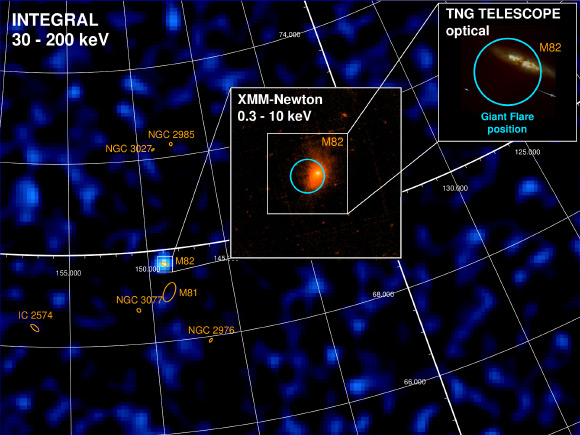Using sensitive instruments onboard ESA’s International Gamma-Ray Astrophysics Laboratory (Integral) mission, astronomers have detected a gamma-ray burst named GRB 231115A from the center of Messier 82 (M82, NGC 3034 or the Cigar Galaxy), a starburst irregular galaxy located 12 million light-years away in the constellation of Ursa Major. They suggest that GRB 231115A’s spectral and timing properties, together with X-ray and optical observations a few hours after the event and the lack of a gravitational wave signal, indicate that this burst was the result of a giant flare from a magnetar. They conclude that starburst galaxies such as Messier 82, known to produce magnetars, may be promising targets for studying giant flares.

On November 15, 2023, Integral detected a burst of gamma-rays for only a tenth of a second. The detection was sent to the Integral science data center, where software determined it came from the nearby galaxy Messier 82. The small square on Integral’s map shows the location of the burst. The blue circle on the two cut-out images shows the corresponding location. Image credit: ESA / Integral / XMM-Newton / INAF / TNG / M. Rigoselli, INAF.
Giant flares are short explosive events releasing extremely large amounts of energy as gamma-ray bursts (GRBs).
Only three such flares have been seen from magnetars in our Milky Way Galaxy and the nearby Large Magellanic Cloud in around 50 years.
Observations of giant flares from magnetars further afield are impeded by the fact that the source of energetic bursts can be difficult to determine at long distances.
“Some young neutron stars have extra strong magnetic fields, more than 10,000 times that of typical neutron stars. These are called magnetars. They emit energy away in flares, and occasionally these flares are gigantic,” said Dr. Ashley Chrimes, an astronomer at ESA.
“However, in the past 50 years of gamma-ray observations, only three giant flares have been seen from magnetars in our Galaxy.”
“These outbursts are very strong: one that was detected in December 2004, came from 30,000 light-years from us but was still powerful enough to affect the upper layers of Earth’s atmosphere. Similar to how solar flares, coming from much closer to us, influence it. “
“The flare detected by Integral is the first confirmation of a magnetar outside of the Milky Way,” said Dr. Sandro Mereghetti, an astronomer at the National Institute for Astrophysics.
“We suspect that some of the other ‘short gamma-ray bursts’ Integral and other satellites have revealed are also giant flares from magnetars.”
“This discovery opens our search for other extragalactic magnetars. If we can find many more, we can start to understand how often these flares happen and how these stars lose energy in the process,” Dr. Chrimes said.
“However, outbursts of such short duration can only be captured serendipitously when an observatory is already pointing in the right direction,” said Integral project scientist Dr. Jan-Uwe Ness.
“This makes Integral with its large field of view, more than 3,000 times greater than the sky area covered by the Moon, so important for these detections.”
“Messier 82 is a bright galaxy where star-formation takes place,” the authors said.
“In these regions massive stars are born, live short turbulent lives and leave behind a neutron star.”
“The discovery of a magnetar in this region confirms that magnetars are likely young neutron stars.”
“The search for more magnetars will continue in other star-forming regions, to understand these extraordinary astronomical objects.”
The findings were published in the journal Nature.
_____
S. Mereghetti et al. A magnetar giant flare in the nearby starburst galaxy M82. Nature, published online March 7, 2024; doi: 10.1038/s41586-024-07285-4

